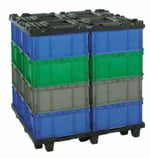How to Model Amazon’s Frustration-Free Packaging
 Ten years ago, Amazon introduced frustration-free packaging. According to Amazon, it was “designed to reduce waste and delight customers with easy-to-open, 100% recyclable packaging.” If you’re not familiar with what this is, it’s why you haven’t had to deal with plastic bindings, wire ties, and clamshell casings when you order from Amazon. It’s also why the boxes are so easy to open without a sharp object.
Ten years ago, Amazon introduced frustration-free packaging. According to Amazon, it was “designed to reduce waste and delight customers with easy-to-open, 100% recyclable packaging.” If you’re not familiar with what this is, it’s why you haven’t had to deal with plastic bindings, wire ties, and clamshell casings when you order from Amazon. It’s also why the boxes are so easy to open without a sharp object.
The idea has done far more than increase customer satisfaction. According to this article, the savings are astronomical:
“In 2017 alone, Amazon has delivered 120 million shipments with packaging that is certified Frustration-Free or Ships in Own Container. To date, Amazon’s sustainable packaging innovations have eliminated 181,000 tons of packaging material and avoided 307 million shipping boxes—enough boxes to fill more than 550,000 semi-trucks.”
These numbers look pretty appealing to any manufacturer or DC. So is there any way you can emulate the frustration-free packaging for your own company?
Unless you already have the most sustainable and optimal packaging possible for your products, the answer is yes.
Assuming you’re most interested in reducing waste and cutting costs, there are three main factors to consider. The first is the size of your packaging. If you have a one-size-fits-all package for more numerous products that are not the same size, consider how much extra space is in some of those boxes. It necessitates more filler, uses more room in the pallet and on the truck, and wastes materials.
The second question you need to ask is how sustainable your current packaging is. This isn’t just about recyclable or recycled materials, though those are two great avenues to reduce your footprint. You may also be able to take advantage of reusable containers to cut costs. Additionally, are you receiving packaging materials that you can reuse, like filler?
Speaking of filler, that itself is the third factor to evaluate. If your filler isn’t appropriate for the level of protection your products need, you could be wasting a lot of money using too much or a more expensive option than necessary. For some companies, custom boxes that fit components exactly prove to be less expensive in the long run despite initial cost increases.
These don’t only apply to large-scale shipments, either. Frustration-free models are useful for situations like shipping large or fragile components to and from tradeshows. With containers designed for individual products or modules, protection is increased, and setup/breakdown time is drastically reduced.
To get the most out of your packaging system, use an expert like Packnet. Our engineers will listen to your goals and concerns to produce a solution that meets your needs. Contact us at 952.944.9124 or [email protected].
